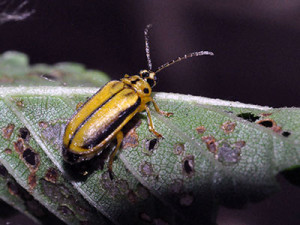
LA JUNTA, Colo. – Elm trees in southeast Colorado are having a bad year. On the heels of years of drought, which already had reduced overall tree health, they are suffering from a one-two punch of a dramatic temperature decline last November – from the high seventies to well below zero in just a few days, damaging trees that had not yet gone dormant.
As a result of the weather extremes, many trees are declining or even dying, and now the beetles are causing their leaves to brown out, adding to their damaged appearance.
Donna Davis, district forester for the Colorado State Forest Service La Junta District, says her office has received numerous calls in recent weeks from homeowners and others concerned about their elms. She says these trees and beetles have co-existed since the trees were introduced here, but elms that lost leaves and branches as a result of past weather events weakened them and made them susceptible to significant damage from the insects this year.
Siberian, American and English elms all are being impacted in counties including Crowley, Otero, Bent, Kiowa, Cheyenne, Prowers, Baca and Las Animas.
“Persistent drought and last fall’s rapid temperature drop are probably the biggest drivers of the current elm decline in southeast Colorado,” said Davis. “But now the elm leaf beetle is having a much greater impact than usual, possibly because there are simply less leaves for the insects to feed on.”
Elm leaf beetles, which favor Siberian elms but can impact all elm species, can cause relatively negative effects. They feed on leaves, making them dry out and turn a brownish color as they die off. Repeated attacks can weaken trees and make even healthier ones prone to significant branch dieback.
Davis says it is difficult to determine whether some of the weather-impacted trees will survive into next year. She says landowners should wait and see if the trees leaf out next spring, and in the meanwhile regularly deep-water their trees in the root zone, from now through the winter.
She also cautions against using insecticides at this time, as it likely would not be beneficial this late in the summer and could negatively affect other non-target insects.
“These beetles already have almost completed their second generation this year. So spraying trees now will be like shutting the gate after the horse is already out,” Davis said.
For more information about elm leaf beetles, landowners can refer to a Colorado State University Extension fact sheet available online at www.ext.colostate.edu/pubs/insect/05521.html.
For tree watering tips, visit the trees section of the CSFS website.

